20 000 Leagues Under the Sea, The Calgary Stampede, What Happened to Jones (1916, 1925, 1926)
Directed by: Herbert Blaché, Stuart Paton, William A. Seiter
Written by: Donald W. Lee, Melville W. Brown, Raymond L. Schrock, Stuart Paton
Starring: Allen Holubar, Hoot Gibson, Jane Gail, Marian Nixon, Reginald Denny, Virginia Brown Faire
EARLY UNIVERSAL VOL. 2 [1916, 1926, 1926]:On Blu-ray NOW: from EUREKA ENTERTAINMENT
Eureka bring us three more films from the early days of cinema.
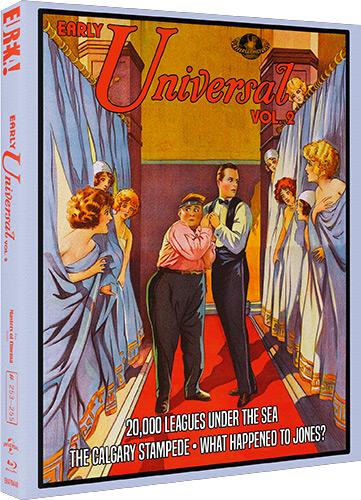
DISC ONE
20,000 LEAGUES UNDER THE SEA [1916]
RUNNING TIME: 85 mins
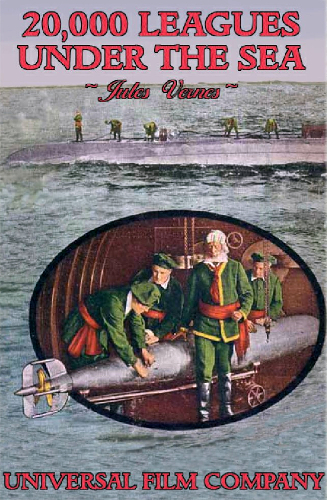
French scientist Professor Arronax, his daughter, his assistant and harpooner Ned Land join the US Navy on the search for a sea monster that’s been seen in the area. Their ship is rammed by said monster, which is actually a submarine captained by Captain Nemo, who’s searching for a man who once did him great evil. Nemo reluctantly rescues the four after they are thrown overboard. Meanwhile four Union soldiers escape a Confederate prison camp in a balloon are marooned on an island where lives a woman who’s been living there for many years. And former British colonial officer in India Denver is haunted by an incident six years before where he tried to rape a woman who killed herself rather than submit to him….
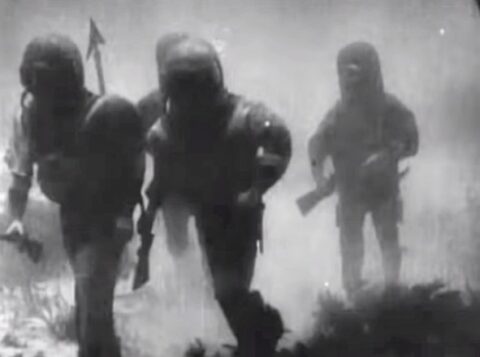
This was by far the film in this set that I was most looking forward to seeing. The first feature length Jules Verne adaptation, made at a time when the majority of films were shorter, and the first film to feature underwater photography, is certainly of historic value, but does it also fare well as entertainment? I’d say that it does, as long as one realises the conventions of the time and doesn’t expect a faithful adaptation – but then the novel has always proved to be a problem to stick close to for two reasons; it consists of far more travelogue than plot, and has a vague anti-Colonial theme which was made more explicit in the sequel The Mysterious Island where Nemo had his beef with the British. So what does screenwriter Stuart Paton, who also directed, do? He combines it with The Mysterious Island and replaces the politics with lots of typical silent film melodrama which, even if I don’t tell you and if you’ve seen a fair few silent movies, you’ll know will most likely feature an attempted rape which is stopped in the nick of time – in fact this one has two. The result is an extremely fast paced series of incidents which only slows down for the section when Nemo’s prisoners are invited to gaze out at the wonders of the deep with him – and it’s worth remembering that, even if dull now, this scene would have thrilled audience of the time. The same can be said even more for the following sequence when some of the characters venture out underwater and encounter sharks with no fakery – though lovers of unconvincing monsters will chuckle at a decidedly static octopus that’s only on screen for a moment, so don’t expect a thrilling battle with it like we saw in the 1954 Disney version, which is to date the only other cinema version though there have been a few for TV.
Ernest and George Williams were the guys who’d just perfected underwater photograph when this film was made, so are thanked and even shown at the beginning, as is Verne, though he’d have probably hated what’s done with his story. Arronax is soon on the hunt for this sea monster but all Ned does is chat up his [unnamed] daughter and put his hands all over her, otherwise barely featuring. Nemo is introduced really early, ruining the suspense of what this sea monster is, though in many ways he becomes the main hero of the piece rather than an anti-hero who seems to have a point and whom you can’t help feel sympathy. The sequel novel’s tale of the castaways, in which Nemo did originally feature anyway though there was no ‘child of nature’, is quite well intercut with the Nautilus material, but what’s with this Denver fellow who’s tormented by this awful event in his past? Considering when this film was made, the plot has been quite well tweaked to ensure 1916 audiences still got their fair share of melodrama, though it’s interesting to have Denver clearly suffering for what he’s done. A large scale flashback set in India that, as the intertitles tell us, reveals “the tragic secret of his life which Verne never told”, features an impressively large set even though the mostly immobile camera doesn’t really do it justice, and many extras, though it feels like we’re in a totally different film. And we finish on a sombre note, with a funeral at sea, though this is one of several scenes that may have been helped if the 17 minutes worth of missing footage from this film has been found. As it stands, it seems rather sudden, and other events are glossed over, with some reliance on the intertitles to provide the plotting. One black character suddenly disappears.
Arronax and company soon take a back seat to the castaways who feature in much more of the action, with much time devoted to the ‘child of nature’ who responds to the kindness of one of the men but is lusted after by one of the others who becomes the other chief villain. None of the performers are particularly great, though I suppose that Jane Gail’s full-on emoting as the ‘child of nature’ does make some sense in terms of the character. Allen Holubar as Nemo often makes do with stiff poses as he presumably tries to act like he’s Indian, though he has have some charisma, while to my eyes his ‘blackface’ isn’t at all offensive in the way that the original minstrel shows are, though I’m aware that some will differ on this. In some respects this film was progressive – did any other American film of the time have a non-white hero? The scenes of the model Nautilus underwater are quite impressive and, while the design is simple compared to the steampunk glory of the 1954 version, the cosy area where Nemo resides is nicely judged, as if he’s trying to cling to his royal past even though he’s a totally different person now, and there’s even an organ, an instrument that Nemo will play in several later films. This 20, 000 Leagues Under The Sea isn’t quite a neglected classic but aspects of it still impress and you most definitely won’t be bored, even if you’re new to this kind of film.
Rating: 









SPECIAL FEATURES
Score by Orlando Perez Rosso
Rosso’s score is quite modern in style with its rhythmic emphasis of cells rather than themes and refusal to exaggerate the emotion, though that also means it trends to remain on one level.
New video appreciation by author / critic Kim Newman [22 mins]
This replaces an audio commentary on the Region A Kino Lorber disc and two interviews on the French Region B Rimini release. A particularly enthusiastic Newman discusses the novel, the film, and why the former is so hard to adapt. We learn that Nemo was Polish attacking Russian ships in his first draft and why that was changed, that this film to far too expensive to ever turn a profit, and that all the early Verne-based films flopped, which is perhaps odd seeing as they came back in the ‘50s to great success. Newman is perhaps a little too apologetic for blackface, but then there are a lot of people who are sensitive about it these days.
DISC TWO
THE CALGARY STAMPEDE [1925]
RUNNING TIME: 92 mins
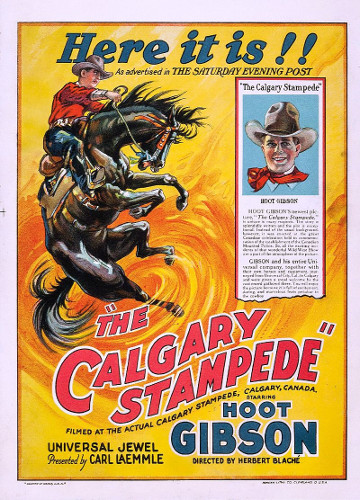
In Canada, expert rodeo rider Dan Malloy goes looking for adventure and falls in love with Marie LeFarge, but her father Jean hates the name Malloy and Marie turns down Malloy’s proposal to please her dad. Meanwhile Fred Burgess, sent to prison on a charge made by Mr. La Farge, is released and wants just revenge. During a confrontation between Malloy and La Farge, Burgess fires a shot which kills La Farge. Marie’s Native Ameican maid Neenah, who loves Burgess, says that nobody has been on the premises except Malloy, who’s accused of the killing and escapes. Two years later, Malloy is a wondering half-wit drifter named Chuck Jones who gets a job at a ranch whose owner Al Morton is entering the Calgary Stampede….
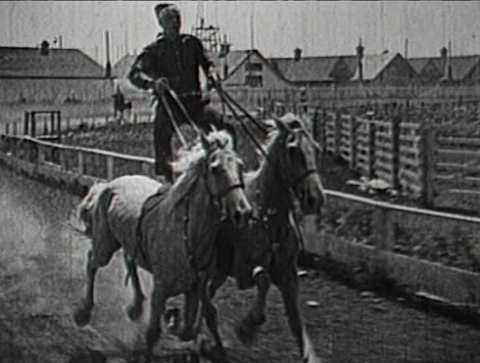
What is the Calgary Stampede, you may ask? Billed as “The Greatest Outdoor Show on Earth’ , it’s an annual rodeo, exhibition, and festival held every July in Calgary, Alberta, Canada, that’s been running since 1919. Now I’ll be honest and say right now that I despise such shows because of their treatment of animals, and it looks like one horse is seriously injured onscreen here, something that I’m surprised is shown in this UK release considering the BBFC’s commendable but annoying censoring of horse falls. In any case, let’s put personal feelings about that aside because there’s some impressive stunt work, especially from star Hoot Gibson who does Roman Riding [standing with one foot on each horse as they both gallop] like he was born to do it. Well, he was a rodeo champion himself. But how is the rest of the film before it turns into a filmed rodeo show? It’s pretty good, with a fairly decent plot that moves slower than 20,000 Leagues Under The Sea but which benefits from some scenes taking their time with more use of closeups than was the norm at the time, while it seems that this is a considerably longer version than was the norm for many years, running 91 minutes instead of 60 minutes which both the IMDB and Wikipedia state is the running time. Despite being a western it has no gunplay except for one killing, and indeed not many of the other expected ingredients, but one should be involved nonetheless.
A title card describing the setting of the first third conveniently but typically omits the fact that the reason the buffalo were disappearing was that the white people were massacring them. Anyway, we meet Malloy, with Marie and whom I assume is a Native American guide though we never properly see his face and he disappears from the film when Malloy says that three’s a crowd. The two are already sweethearts, and in this section especially we get a lot of exaggerated colloquialisms which was normal for the time. Here the plot develops fairly leisurely until the shooting, and then we get a horseback chase followed by a really thrilling sequence where the dastardly Burgess causes a buffalo stampede that will hopefully get rid of Malloy who’s just been caught by Sargent Bill Harkness who’s convinced that he murdered Le Farge. The actors are right there in the middle of it while we’re always aware of the scale of the action, with lots of wide shots. Malloy rescues Harkness, but returns to find that Marie also thinks he killed her father, so he flees and changes his name, to much later show up sat this ranch where he’s content to not show his mastery of horsemanship until this competition looms. But how can be participate with the suspicious Sgt. Callahan snooping around? Will he ever run into Marie again and what will he reaction be? Could Burgess still be around, not to mention Neenah who he dumps? The answers to these things may all be obvious in a tale which has to have all the major players conveniently converge on one location in a contrived fashion, and also just has to happily conclude matters in just as contrived a fashion.
You may be surprised at how exciting some of the rodeo stuff is even if you totally disagree with the intertitles saying that this is “a new chivalry”. You may even cheer our hero on, especially in his final race. Was a carriage race included because of Ben-Hur which hadn’t quite been released yet but which no doubt had its thrilling chariot race already well known? Harry Neumann’s cinematography includes some great shots of people on horses as the camera races alongside and even overtakes them, though director Herbert Blaché seems most happy focusing on the relationships of the characters, and he’s helped by some quite good performances, particularly from Virginia Browne Faire as Marie; she’s especially good in two scenes; one where Marie lets Malloy know that she believe that he killed here father, and another where Marie has to quickly decide whether to show that she recognises Malloy or not. There’s good internal acting here. There’s also a nice shot during their proper reunion where Malloy’s face is bathed in sunlight. Hoot Gibson doesn’t really have the looks, style or build of a typical western hero, even for the time, but he was a major one nonetheless. During the period between World War I and World War II, he was second only to Tom Mix as a box office draw. Unsurprisingly, the other major female character is given short shrift even though she’s important to the plot, but then so is the villain of the piece really and Ynes Seabury manages to make a strong impression anyway. Like many silent films whether complete or incomplete, The Calgary Stampede has some portions which seem rushed, resulting in a certain unevenness, but it’s far more engaging than you might expect.
Rating: 









SPECIAL FEATURES
Score by Chris Tin
Tin cleverly manages to give his score a slight western feel without going for cliches. His themes are pleasant if not really memorable and dramatic scenes receive strong treatment while avoiding archetypal silent movie action music. The heavy emphasis on piano in his musical combo perhaps gives this score more of an archetypal silent movie score than the previous one.
Brand new audio commentary by professor and film scholar Jason A. Ney
Ney’s commentary isn’t very scene specific and spends a lot of time talking about the stars, the director and Carl Laemmle whom we heard a lot about in Volume One, but he certainly doesn’t fall into the trap of chiefly listing credits, and much of the information was totally new to me. We learn that Gibson told an interviewer that the cast members of a film would dress up as Native Americans for the shots of the latter, then reverted back to their proper roles for the shots of the the folk being chased, and also that considered his westerns to be deliberately moral pieces because kids watched them. It’s astounding how popular westerns were back then, the bread and butter of the American film industry if rarely prestige pictures. Ney also explains why the running of silent films often varies; the speed would depend on how fast the projector was running and audiences didn’t not to care about films being sped up. And he makes an interesting point about the film contrasting two forms of masculinity, and finding the typical western over-reacher wanting. He does indeed make a few comments about the film we’re watching, though could have made more. Solid but not exceptional.
WHAT HAPPENED TO JONES? [1926]
RUNNING TIME: 70 mins

Tom Jones is to be married the next day to Lucille Bigbee. She has another admirer in Henry Fuller who tries to get Lucille to give up on Jones and even asks her father to check up on him, implying that he could vey well be disreputable father. Living by the Bigbees are the Goodly’s. Jones catches Ebeneezer Goodly playing poker and is lured in to join the game, but then the place is raided by the police, and Jones and Goodly escape down a fire escape and land in a ladies’ Turkish bath establishment, eventually making a getaway with much difficulty in women’s clothing. At the Goodly residence, Jones dons the clothes of Goodly’s brother, a bishop who’s expected that morning, but this turns out to be a big mistake and causes all sorts of complications….
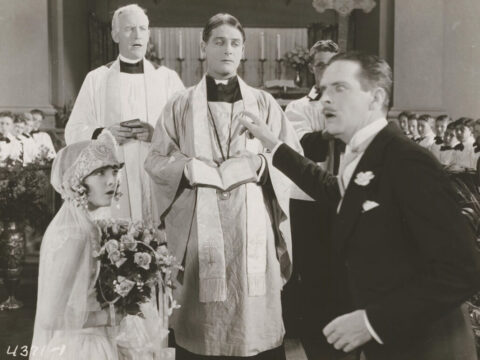
Watching What Happened To Jones?, I wondered again why we find the idea of men in women’s clothing so funny. I mean yes, there are the obvious sexual complications, but even in something as innocent as this I still laughed. And are women in men’s clothing as laugh-causing? I wouldn’t say that they are at all, though of course one must admit that the idea isn’t used anywhere near as often as the other way round. Our normally built hero and his rotund friend find themselves in a Turkish bath place and are just wearing towels, so obviously have to get some actual clothes to wear. After much sneaking around and avoiding of the place’s patrons, they find what they want, but when they escape the establishment they’re hit on by two guys who want to walk them home, which brings up another question. Why do so few people in these kinds of scenes recognise the men for what they are? They still look totally like men despite their garb. Even when trying to hide in steam units, women there think that they’re other women! Of course the answer is that it’s an accepted convention but it’s amazing how we tend to buy it, at least for the duration of what we’re watching. In fact this is only a fairly small section of this farce, adapted by Melville W. Brown from a play by George Broadhurst which had been previously filmed in 1915 and 1920. It’s as straightforward as they come, but I can happily say that I laughed a good number of times and was kept smiling throughout. In my world that’s a success.
The opening is neat because our first long distance shot of a man on his knees before a lady gives the impression that we’re seeing our hero and our heroine, but the guy is in fact another man, devious suitor Henry Fuller, played by William Austin in the only truly over-the-top performance of the film; the way he constantly rolls his eyes gets a bit tiresome but fits the character. Jones sees the two of them together and isn’t happy, though neither is Lucille particularly pleased at her latest wedding gift; two candlesticks with the price tags left on them. Meanwhile Marjorie Goodly and her mother aren’t too pleased when her fiancee Richard Heatherly and her dad go out to play poker. Jones, after not a lot of persuasion, joins them, but the police turn up. There’s much running and even some jumping, plus a lot of heat when the two are wearing clothes and have the temperature turned up in their steam units, before Jones and Goodly get home on a milk wagon to the Goodly household and the plot settles down to its main situation. Hilda the maid sees them come in so they pay her some money to just say “I didn’t see them go out, I didn’t see them go out, I didn’t see nothing” which she repeats like a robot but only after asking for more money. Jones dresses up as a bishop who’s supposed to be much older than he but claims that “electric cabinets and steam baths have made him young”. Of course Lucille recognises him, making Fuller jealous when the two act rather closer than they should be, while Jones is put in the spot several times, such as being asked to say a few words of prayer at the dinner table. Without revealing everything, he’s then asked to officiate at his own wedding. The way things are resolved is unconvincing even for a comedy, but there’s a funny ending and we’ve have some fun leading up to it so we don’t mind.
It’s all simple situations but very well played and timed. The occasional little piece of slapstick appears. The performers, except for the one I’ve already mentioned , don’t mug and treat their rolls with respect. I didn’t really warm to Denny in Skinner’s Dress Suit which was on Volume One, but here I found him to be quite effective, especially as the bishop. I doubt whether the script would have got past the censors after 1934 when censorship became really tight; I wouldn’t say that clergymen are actually mocked here, but some of the situations may have still been deemed a bit too much by the puritan protectors of the public from indecency and blasphemy. Most of the cast members have to act pretending that they don’t know who someone is or act genuinely not knowing who someone is; they play really well as a group and spark off each well and often surprisingly subtly. My favourite performer is Zasu Pitts as Hilda; she has great comic timing , though she’s probably better knowing for her serious parts, notably her part in Greed. I’d say that she was a darn fine actress all round and a name that deserves to be better known. Director William A. Seiter just lets the performers perform, rarely moving the camera,, but has a knack for a well-timed long distance shot – or can that be put more down to cinematographer George Broadhurst? What Happened To Jones? is a neat little comedy and I liked it a lot.
Rating: 









Score by Anthony Willis
An appropriately jaunty score which continually repeats the same few themes and motifs but emphasises moments of emotion well and never quite becomes the expected comedy music; it’s rather restrained. An organ can be heard at certain moments.
Brand new audio commentary by film historian and writer David Kalat
Kalat brings up another rarely scene-specific – and in fact not even that film-specific – commentary that’s nonetheless usually interesting because of his slightly conversational style of talking. His main theme is why Denny and this movie haven’t been celebrated, especially considering how the Big Three of silent comedy have been constantly revered ever since that James Agee article in 1948 said how silent comedy is much better than sound comedy, and the answers he gives are surely the reasons. One I found especially intriguing but rather sad is that Denny was also a serious actor, therefore in the minds of many people less associated with comedy. He also describes the play which he has a very low opinion of, and tells us tells us a lot about Denny’s full life, from being sexually abused at school to pioneering drone planes though not getting the due recognition for the latter.
SPECIAL FEATURES
Limited Edition O-Card slipcase [2000 copies]
1080p presentation on Blu-ray from restorations undertaken by Universal Pictures (20,000 Leagues Under the Sea and What Happened to Jones? restored in 4K, The Calgary Stampede restored in 2K)
20.000 Leagues Under the Sea alternates between looking very clear and sharp for its age, with especially strong blacks, and very faded and scratchy. Unfortunately, the latter happens most often in the underwater scenes, but it obviously can’t be helped. Eureka present it in black and white, unlike the other two which are mostly sepia with blue for nighttime scenes. There are far fewer rough looking scenes in those, and the contrast is often genuinely brilliant for films this old. Fans of really vintage films should be very happy.
A collector’s booklet featuring new writing on the films
Three more well chosen titles from different genres. These should be easy to get into and enjoy even if you’re not experienced with films this old. Recommended.


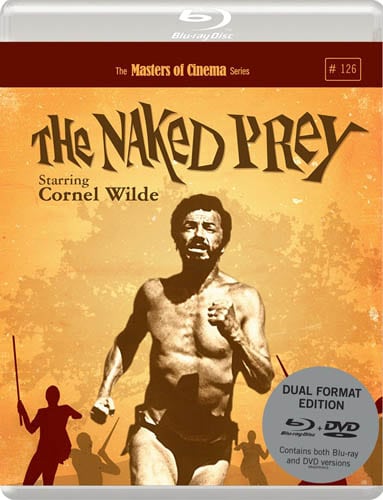
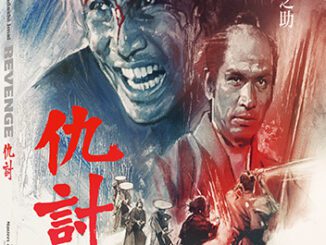
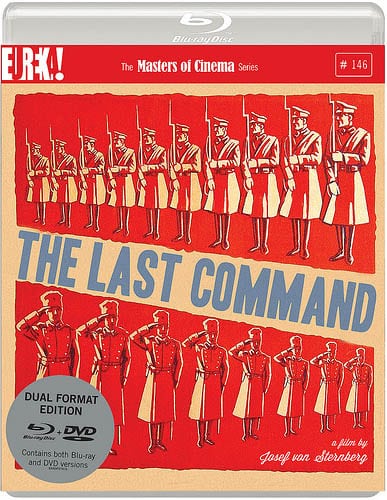
Be the first to comment